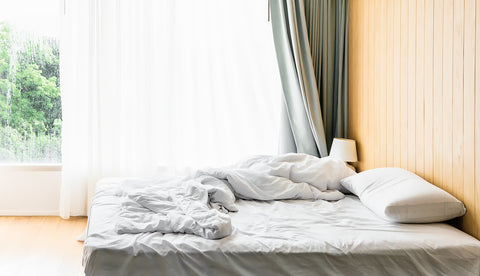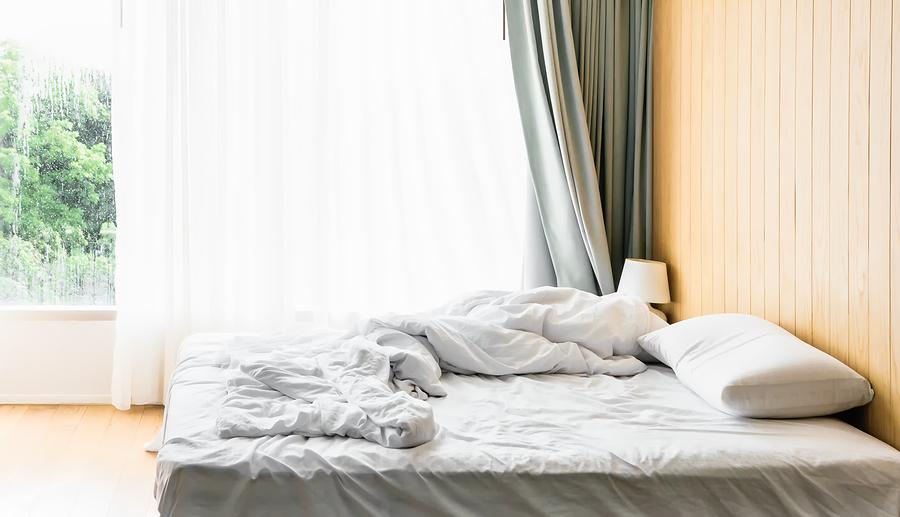Here at SensaCalm, one of the most common questions we receive is 'how heavy should a weighted blanket be?' The answer depends on your size, needs and the recommendations of your occupational therapist or other health professional. Here is a comprehensive guide to choosing the most effective weight for your needs, along with answers to some of the top questions about weighted blankets and weighted blanket therapy.

How Heavy Should Your Weighted Blanket Be?
When choosing a weighted blanket, it’s important to remember that everyone has unique needs and preferences. Whereas one person may prefer a heavier weight, another individual may do better with a lighter blanket. There are no hard and fast rules for determining how heavy your weighted blanket should be. The short answer is that you should choose the right weight for you.
However, we have put together basic guidelines to give you an idea of which weights tend to work well based on our experience, as well as feedback we’ve received from our weighted blanket users.
As a general rule, weighted blankets should be sized to the body — not a bed.
The Weighted Blanket Weight and Size Guide
-
Weighted Blankets Are Not For Babies - It’s important to remember that you should never use a weighted blanket for a child under one year of age. As a parent, you’ve probably heard about Sudden Infant Death Syndrome (SIDS) from your pediatrician or other health care provider.
Although the exact cause of SIDS is still unknown, doctors say it can occur when babies sleep with loose blankets, crib bumpers or plush toys. Some SIDS cases also occur when babies are placed on their stomachs instead of their backs when they sleep.
According to the St. Louis Children’s Hospital, weighted blankets are not safe for infants, which include children between the ages of birth and one year. Any amount of weight during sleep is inappropriate for a baby.
If you struggle to help your baby sleep well at night, you are most definitely not alone. Dr. Kathryn Bucklen, a pediatrician at St. Louis Children’s Hospital, offers some great tips for getting baby to sleep safely and soundly.
-
Weighted Blankets for Toddlers - First, keep in mind that you should not use a weighted blanket for any child under one year of age.
It’s also important to speak to your doctor, occupational therapist or other health professional before using a weighted blanket. For children between the ages 1 and 6, we recommend a size Small weighted blanket.
To calculate the correct weight, use 10 percent of the child’s body weight plus one pound. The Small measures 34 inches by 50 inches.
-
Weighted Blankets for Elementary Age Children - how heavy should a weighted blanket be for a child? For children between the ages of 6 and 12, we recommend a size Medium weighted blanket. The Medium measures 38 inches by 62 inches. To calculate the appropriate weight, use 10 percent of the child’s body weight plus two pounds.
Small Weighted Blanket
Child Weight Blanket Weight 20-pound child 3lbs 30-pound child 4lbs 40-pound child 5lbs 50-pound child 6lbs 60-pound child 7lbs 70-pound child 8lbs Medium Weighted Blanket
Child Weight Blanket Weight 30-pound child 5lbs 40-pound child 6lbs 50-pound child 7lbs 60-pound child 8lbs 70-pound child 9lbs 80-pound child 10lbs 90-pound child 11lbs 100-pound child 12lbs 110-pound child 13lbs 120-pound child 14lbs 130-pound child 15lbs
As with adults, some kids like a little more weight, while others prefer a bit less. We offer a generous and reasonable return policy, so you can exchange your weighted blanket for a different size or weight depending on your child’s preferences and comfort.
We also offer sample fabrics so you can see how a fabric feels before you order. Just contact us for a sample.
-
Weighted Blankets for Teens and Adults - For individuals age 13 and up, we recommend the Large size weighted blanket. You calculate the weight for the blanket by using 10 percent of the person’s body weight plus three pounds.
In many cases, we recommend adding a few pounds beyond 10 percent. When you order your custom weighted blanket, you’ll see a handy weight chart, which makes it easy to select the right weight.
As a note, larger blankets are heavier because they require moreweight to apply the same amount of pressure over a larger surface area.
Adults tend to have an upper limit to the amount of weight that they want in a blanket. To help adults choose the perfect weighted blanket for them, we’ve created the chart below:
Adult Starting Weight Guide
Weighted Blanket Size Blanket Weight Medium 12lbs Large 15lbs Full 20lbs Queen 30lbs For Elderly or Frail Adults
Weighted Blanket Size Blanket Weight Small 5lbs Medium 8lbs
As you order your SensaCalm weighted blanket, the main thing to keep in mind is that we create custom blankets depending on your needs and preferences. Some people like a heavier weighted blanket. On the other hand, some users sleep better with a lighter weighted blanket. There is no right or wrong when it comes to weight — only what makes you comfortable!
Keep in mind that everyone is different, and you may prefer a little more or less weight. If you have questions, don’t hesitate to contact us. We’re here to help!
It’s also important to remember that your weighted blanket should fit your body and not your bed. If you size it to drape over the sides of your mattress like a regular, non-weighted blanket or comforter, gravity will do its thing — which means waking up to a weighted blanket puddled on the floor.
- Full and Queen Size Weighted Blankets - If you are a large person, or you’re a couple who would like to share the blanket, you can purchase a Full or Queen size. Our Full size weighted blankets measure 56 inches by 72 inches. Our Queen size blankets measure 64 inches by 72 inches.
Please note that Full and Queen sizes are designed to lay on top of a bedspread rather than hang off the sides like a standard bedspread or comforter. This design is intentional, as a weighted blanket with any overhang will naturally succumb to the forces of gravity and constantly pull down toward the floor.
Additionally, if you tend to toss and turn at night, a Full or Queen size may be ideal for you. Some restless sleepers find that a larger size weighted blanket gives them a little more “wiggle room” as they shift around.
One of the things that sets SensaCalm apart from other weighted blanket companies is our commitment to personalized service. If you’re unsure of which weight to choose, we will work with you to determine the best weight and size blanket for your needs. We have weighted blankets that are ready to ship today, and we also offer a large catalog of custom weighted blankets made-to-order specifically for you, your child or a loved one.
For more information about choosing the right weight, please check out our sizing page.
How Much Weight Should be in a Weighted Blanket?
As you can see in the answers above, there is no magic number for everyone. The reality is that weighted blankets are incredibly customizable things. For some people, a heavier blanket is better. On the other hand, some of our other customers just want a little bit of weight — they’re just looking for a gentle sensation.
If you don’t know — or can’t settle on a size or weight for your blanket — just grab one and try it! There’s a good chance you’ll end up falling in love no matter what size it is.
If it doesn’t work for you, that’s okay — we offer a generous return policy, so you can exchange your blanket for something that works better for you or your child.
What Is the Right Size Weighted Blanket for You?

At SensaCalm, our weighted blankets are made to fit the user’s body. We find that parents, caregivers and individual users see the most benefits when their weighted blanket is sized to accommodate them and not necessarily their bed.
This is because weighted blankets may be an effective tool in managing the symptoms of sensory processing disorder and related conditions. According to WebMD, “Sensory processing disorder is a condition in which the brain has trouble receiving and responding to information that comes in through the senses.” Sensory processing disorder can affect both children and adults, and symptoms can range from very mild to severe.
Every human being on the planet experiences life through his or her senses. From smelling different aromas as you walk through a mall food court to hearing a mix of sounds in a movie theater, we all rely on our senses to inform us about the world. For people with sensory processing disorder, however, something in the brain throws up a roadblock that either jams sensory input or prevents the brain from interpreting it correctly. According to the STAR Institute for Sensory Processing Disorder, “A person with SPD finds it difficult to process and act upon information received through the senses, which creates challenges in performing countless everyday tasks.”
One of the most common symptoms of sensory processing disorder is insomnia or restless sleep. In children, sensory processing disorder can lead to tantrums and other behavioral issues. Weighted blankets apply deep, even pressure — sort of like a gentle, comforting hug. This soothing pressure has been scientifically shown to ease anxiety and promote peaceful sleep. By sizing the blanket to the body rather than the bed, we ensure that this therapeutic pressure gets applied to as much of the body as possible.
What Is Weighted Blanket Therapy?
Weighted blanket therapy may be an effective tool for sensory processing disorder, but it has also been shown to potentially help a variety of other conditions in children, adults and the elderly. From insomnia and anxiety to fibromyalgia and restless leg syndrome, there are a host of health conditions that may respond well to weighted blanket therapy.
The science behind weighted blanket therapy is that “deep pressure touch” reduces cortisol levels and boosts the production of serotonin in the brain. Cortisol, which is also known as the “stress hormone,” has been linked to numerous diseases and conditions, including headaches, heart disease, weight gain and digestive difficulties. When the brain perceives a stressful situation, it naturally signals a “fight or flight” response. This isn’t necessarily a bad thing, as it spurs the individual to deal with the stress in the safest, most productive way possible.
The problem arises when the brain produces too much cortisol. This can happen when a person encounters too many stressful situations. For many people, even everyday stressors at work and home can create a constant state of anxiety. When the brain is always in a “fight or flight” state, cortisol levels can skyrocket. In individuals with sensory processing disorder and related conditions, triggering noises, sounds and environments can create ongoing stress. This has a negative impact on a person’s overall health.
The Science Behind Weighted Blanket Therapy

There are many ways to deal with stress and hopefully lower cortisol levels. Healthy, natural ways to manage stress include getting plenty of exercise, eating a balanced diet and making sure you get the right amount of sleep for your age. Research has also shown that massage, such as deep pressure touch therapy, can also help reduce the stress hormone and promote the production of hormones that give a sense of well-being.
For example, a study published in the Journal of the Formosan Medical Association found that dental patients undergoing wisdom tooth extraction felt less stress while lying under a weighted blanket compared to patients who did not. The study used weighted blankets that were 10 percent of the patient’s body weight. As the researchers noted, “Deep pressure input is a type of tactile pressure stimulation exerted by firm touching, holding, stroking, hugging, swaddling, and squeezing, and it is carried by the dorsal column-medial lemniscal system to the somatosensory cortex.”
The results revealed that the patient group who used weighted blankets had lower heart rates and more regular heartbeats throughout the procedure. Researchers stated, “Our results further suggest that deep pressure input may be an appropriate therapeutic modality for use in people with special needs with arousal regulation during or in preparation for stress conditions…”
Most people aren’t surprised to learn that a weighted blanket may offer a therapeutic effect. If you have ever felt comforted by wrapping up in a down comforter, or you’ve enjoyed the gentle pressure of a protective lead vest at the dentist’s office, you’ve experienced the benefits of a weighted blanket. With a SensaCalm blanket, you or a loved one can enjoy these benefits at home, during sleep or even on the go. Many of our customers tell us their child uses their weighted blanket in the car, at daycare or during rest periods at school.
Order Your SensaCalm Weighted Blanket Today
Weighted blanket therapy may help reduce anxiety and other symptoms of sensory processing disorder. SensaCalm has been the industry leader in weighted blankets since 2008. Order a custom weighted blanket that is sized and weighted just for you today by calling us at 855-736-7222. You can also reach us online through our contact form.
Disclaimer: The content on this website is not intended as a substitute for medical advice. Talk to your doctor or healthcare provider before undertaking any type of therapy or treatment.


